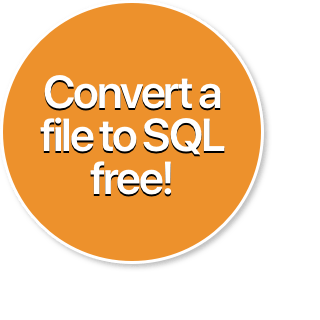Why would a developer convert Excel, XML or JSON to a SQL database INSERT statement?
There are several reasons why a seasoned software developer might want to convert a file (Excel, CSV, XML or JSON) to a SQL database INSERT statement:
- Data Persistence: SQL databases provide a more reliable and efficient way of storing data for long-term use. Converting files to SQL INSERT statements allows developers to store the data in a database, ensuring data persistence.
- Data Integrity: SQL databases have mechanisms like constraints, triggers, and transactions that help maintain data integrity. By converting files to SQL INSERT statements, developers can leverage these features to ensure the accuracy and consistency of data.
- Efficient Data Retrieval: SQL databases allow for efficient retrieval of data through complex queries. This can be particularly useful when dealing with large datasets.
- Concurrency Control: SQL databases provide mechanisms for handling multiple concurrent users or processes, which is not possible with flat files like Excel, CSV, XML or JSON.
- Security: SQL databases often have built-in security features such as access controls and encryption. By storing data in a SQL database, developers can take advantage of these security features.
- Scalability: SQL databases are designed to handle large amounts of data and can be scaled up or down as needed, making them a more flexible option for data storage compared to flat files.
- Interoperability: Many different applications and programming languages can interact with SQL databases, making them a versatile choice for developers. Remember that while there are many benefits to using SQL databases, the best choice depends on the specific needs and constraints of your project.
🖤 SQLizer team.
About: SQLizer offers free conversion for datasets with less than 5,000 rows, designed for personal use. If you have a CSV file with more than 5,000 rows that needs conversion, you can use the code CONVERTME10 to get a 10% discount on your Pro Monthly plan for the initial 12 months or enjoy a one-time 10% reduction on your Pro Annual plan.
More from The Official SQLizer blog...
- Announcing the shutdown of SQLizer SQLizer is shutting down on Sunday August 31, 2025. Sadly, after 10 years and billions of rows of data, it’s time to say goodbye to...
- Convert Anything to SQL for $9 - Unlimited Rows It’s back! Many moons ago, we offered a 24-hour pass on SQLizer, and we’re thrilled to announce that it’s back once again! With this offer,...
- All new: A JavaScript Client for SQLizer on npm Rejoice, JS developers! A JavaScript client library for SQLizer.io, easily converting CSV, JSON, XML and Spreadsheet files into SQL INSERT or UPDATE statements - is...
- [Update 2024] Convert JSON to SQL: Free and Fast If you want to convert JSON to SQL there’s no concrete or straightforward way of doing things. Conversion is usually tricky because JSON and SQL...

